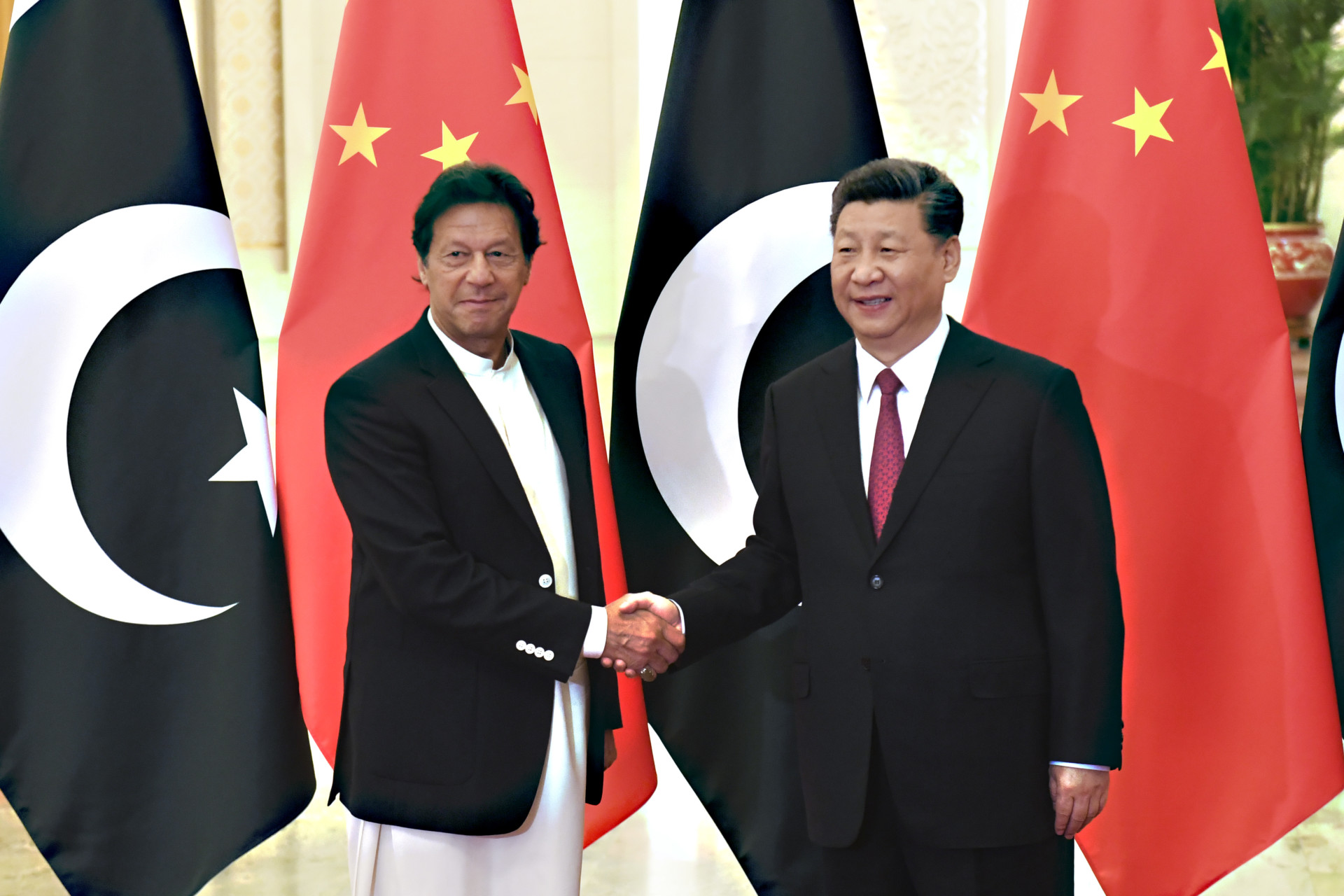The United States and China are locked in a new era of great power competition, the implications of which are being felt around the world, perhaps most acutely in Pakistan. With American strategic priorities undergoing a post-election transition, the cost of ignoring Pakistan runs the risk of compelling the economically struggling country more firmly into the Chinese camp, and in turn exacerbating regional instability. The most problematic outcomes of not paying adequate heed to this tenuous situation would include worsening prospects of stabilizing Afghanistan, increasing tensions between India and Pakistan, and escalating the chances of conflict in a heavily nuclearized region.
The U.S. government can still salvage this evolving situation by using more flexibility in managing its strategic rivalry with China in South Asia. To do this, Washington should implement key policy prescriptions emerging from ongoing work focused on making the bilateral U.S.-Pakistan relationship more stable and from a recent Newlines Institute webinar on the Pakistan-specific implications of unfolding U.S.-Chinese tensions.
To prevent an already volatile South Asia from becoming a proxy arena for the U.S.-Chinese rivalry, a rethink of the growing American reliance on India to counterbalance China is needed, especially on issues that could damage America’s longstanding relationship with Pakistan. The United States must also continue its economic collaboration with Pakistan, which in turn will lessen Pakistan’s growing dependence on China. While the United States should continue pressuring Pakistan to dissuade use of militant proxies in neighboring states, it must also begin to hold Afghanistan and India to the same standards. Washington also needs to redouble its traditional mediation and conflict resolution role in South Asia, given the heightened cross-border volatility sparked by recent skirmishes between China, India, and Pakistan over their territorial disputes in the Himalayas.
China’s increasing assertiveness is evident on both its eastern and western flanks. The United States has sought to respond to this challenge by rebalancing its strategic priorities by articulating an Asia-Pacific pivot. China’s increasing influence in Nepal, Bangladesh, and Sri Lanka has caused much consternation in India, which views this influence to be undermining its position as the local hegemon. However, it is Pakistan’s tightening embrace of China that has become an issue of major concern for both India and increasingly the United States.
Perhaps more than any other country, Pakistan finds itself most squarely caught up in the spiral of worsening U.S.-Chinese relations. This rivalry cannot be understood using binary Cold War era logic; and it is necessary to adopt nuanced frameworks to comprehend the Sino-American situation. It would be equally important to avoid viewing Pakistan’s relationship with China as a zero-sum game.
There is no denying that Islamabad has become increasingly dependent on Beijing at a time when China is emerging as Washington’s biggest foreign policy challenge. Yet Pakistan is still trying to maintain a fine balance between preserving its longstanding ties with the United States and its increasing cooperation with China. It is important to appreciate the factors that have tilted Pakistan toward China and pay heed to emergent realities of this enhanced bilateral relationship. U.S. policy makers must not only avoid viewing Pakistan’s relationship with China as a zero-sum game but also recognize and make use of existing opportunities to temper Chinese influence in Pakistan.
Pakistan’s Relations with China and the U.S.
The Sino-Indian conflict in 1962 provided the rationale for Communist China to forge a bond with the Islamic Republic of Pakistan predicated on the principle of an enemy’s enemy becoming a close friend. China’s support has proven invaluable for Pakistan to maintain some semblance of parity in its lingering tussle with India. But Pakistan had simultaneously aligned itself with the United States by signing Cold War pacts like the Central Treaty Organization and Southeast Asia Treaty Organization to access significant U.S. economic and military aid.
Pakistan not only managed to balance its ties with both the United States and China, it was even a major facilitator in U.S.-Chinese negotiations in the 1970s, leading to the 1972 détente between them. The Soviet invasion of Afghanistan in 1979 led Pakistan to focus on developing a close relationship with the United States and Saudi Arabia to mobilize Islamist guerillas in a decade-long insurgency that forced the 1989 Soviet withdrawal from Afghanistan. Thereafter, the United States lost interest in South Asia, and its relationship with both India and Pakistan was further strained after tit-for-tat nuclear tests by the two countries in 1998.
Meanwhile, China’s cooperation with Pakistan remained consistent, though primarily confined to security matters. China has played a major role in providing conventional military assistance as well as support for Pakistan’s nuclear ambitions, which proved especially valuable while Pakistan was facing U.S. sanctions.
The post-9/11 U.S. need to secure Pakistan’s support of its regime-change efforts in Afghanistan brought another thaw in the bilateral relationship, including an increased inflow of funds. Despite being a “frontline state” in the “global war on terror” and being declared a major non-NATO ally in 2004, relations between Pakistan and the U.S. have been severely tested over the past two decades. Pakistan often felt that the sacrifices it made in the war – which triggered a wave of Islamist terrorism and took a heavy economic toll on the country – were not being appreciated, and instead it was constantly being pressured by the United States to do more. On the other hand, American suspicions of Pakistan being duplicitous in its fight against Islamist militants kept re-emerging, while the Pakistanis felt that the Americans were blaming them for their own inability to stabilize Afghanistan. Despite the flow of generous U.S. aid to Pakistan, bilateral relations have remained erratic over these past two decades.

Washington’s singular focus on achieving its own strategic goals in Afghanistan meant that it paid little attention to empathizing with Pakistan’s regional insecurities, such as the growing influence of India in Afghanistan. Strained ties with the United States led Pakistan to try deepening its ties to China, in part prompted by U.S. moves to forge closer ties with India to counterbalance China. China welcomed these moves given Pakistan’s strategic and economic value, in turn spurring enhanced military ties as well as the cultivation of an unprecedently close economic relationship.

Heightened bilateral relations between China and Pakistan have a historical basis, and they have been facilitated by persistent Pakistani initiatives, instead of being the result of a unilateral Chinese strategic imposition. It was President Pervez Musharraf who first pitched the idea of China helping build the Gwadar port in 2001. In 2013, President Asif Ali Zardari asked China to take over management of the Gwadar deep-sea port from the Singapore Port Authority. Prime Minister Nawaz Sharif was an enthusiastic proponent of the China Pakistan Economic Corridor (CPEC) project, which was launched in 2015 as a flagship for the larger Belt and Road Initiative (BRI). The launching of CPEC (and the project’s estimated value growing from $46 billion to $62 billion) lent the Pakistani economy a much-needed lifeline at a time when Pakistan’s relations with other international partners, especially the United States, had become increasingly strained.

While most of the Chinese commitments via CPEC are in the form of loans, the sheer size of this financial assistance far outweighs the bilateral aid provided to Pakistan by the United States since 2009, which included commitments of over $5 billion in civilian assistance to Pakistan and another $1 billion in emergency humanitarian response. The United States is also Pakistan’s largest trading partner, with which Pakistan had a trade surplus of $1.3 billion in 2019, but that too remains a modest amount in comparison to the scale of the Chinese financial inflows into Pakistan. Beyond prospects of boosting bilateral economic ties, CPEC also has strategic value for China, providing it access to the Arabian Sea via Gwadar.
Recent Developments

While the United States initially welcomed China’s decision to enhance economic cooperation with Pakistan, it has become increasingly wary of the BRI, especially Chinese development of strategic ports in Sri Lanka, Pakistan, Sudan, and Djibouti. China’s reported $400 billion deal with Iran has sparked further fears of another strategic port being planned in the Strait of Hormuz.
China’s apparent move to loop in Iran into the BRI could serve to undermine Indian investments in the Chabahar seaport, located not too far from Gwadar. China tried to involve India in the BRI, but India has been increasingly suspicious of Beijing’s “String of Pearls” doctrine geared toward a strategic encirclement of India in the Indian Ocean. With the Sino-Indian relationship having become more adversarial after border skirmishes in the Kashmir region this past summer, Indian involvement in the BRI seems highly unlikely.
Meanwhile, the U.S. government warned last year that it would not let Pakistan use International Monetary Fund loans to pay off Chinese debt, and it has also publicly warned Pakistan not to fall prey to Chinese “debt diplomacy.” Pakistan has not paid much heed to these warnings, with Pakistan’s foreign ministry asserting that CPEC loans constitute under one-tenth of Pakistan’s international debt burden and that with minimal interest rates and a maturity period of 20 years, CPEC loans currently pose no pressure on the Pakistani economy.
Despite ambitious plans, CPEC projects thus far are only a third of their total projected size, $25 billion instead of $62 billion, due to varied implementation hurdles and domestic security challenges. A recent assessment forecasts that CPEC will largely focus on completing investments that have already been agreed upon and move ahead with considerably slimmed-down plans for future projects. A more modest scope of CPEC projects would yield the benefit of lessening concern for Chinese use of “debt diplomacy” in Pakistan.
However, it is also important to acknowledge CPEC’s elevated position within China’s larger BRI ambitions. Pakistani and Chinese officials keep reiterating their resolve to remove bottlenecks in CPEC implementation. Pakistan has also just given approval to the most expensive component of CPEC, which involves a $6.8 billion project to upgrade railway lines. Chinese Premier Li Keqiang is scheduled to visit Pakistan soon as well.
Whether CPEC can get a major boost despite the further weakening of Pakistan’s economic situation due to the COVID-19 pandemic remains to be seen. While China has come out of the pandemic relatively unscathed, its status as the factory of the world is being damaged due to increasing punitive economic actions by the United States, India, and Europe. China’s growing ostracization could limit its ability to provide further CPEC financing. Conversely, the formation of the Regional Comprehensive Economic Partnership, a free-trade agreement made up of 10 Southeast Asian countries, South Korea, China, Japan, Australia and New Zealand, is being welcomed in Pakistan. Pakistan considers the inking of the agreement an affirmation of China’s global economic ascendency and as a complementary initiative with the potential to boost CPEC plans.
While muted, there is lingering disgruntlement in Pakistan concerning the top-heavy, opaque, and non-participatory way in which CPEC projects are being implemented. The Pakistani military is in charge of providing security to CPEC projects, and the powerful CPEC Authority created last year to facilitate project implementation is also headed by a retired general, which has caused domestic and international consternation.
The question now is whether the United States should further distance itself from Pakistan given the latter’s enhanced ties with China. Maximalist assessments may conclude that the United States needs to focus on building relations with India and let China deal with the security challenges and other impediments that make forging a mutually beneficial economic relationship with Pakistan challenging. But Pakistan remains willing to repair and even expand its bilateral relationship with the United States, and neglecting it may create a self-fulling prophecy that pushes Pakistan firmly into China’s camp.
Impending Challenges
There are vital structural incentives for the United States to continue cooperation with Pakistan, despite its closer relationship with China. The broader U.S. strategic framework to contend with China should be nuanced enough to avoid forgoing mutually beneficial opportunities for bilateral cooperation with Pakistan.
The United States needed Pakistan’s help to bring the Taliban to the negotiating table, and Pakistan can play an important role in ensuring some semblance of stability in Afghanistan after the impending American pullout. China, on the other hand, has not taken up much responsibility in stabilizing Afghanistan, other than providing limited natural resource investments and offering Afghanistan a market for its agricultural exports. Yet, it is not in China’s interest to undermine U.S. goals of stabilizing Afghanistan. Increased militancy in Afghanistan could pose security threats for China itself, especially due to contentious Chinese policies to suppress its own Muslim populations.
While China, the United States, and Pakistan have overlapping interests regarding the future of Afghanistan, there are specific Pakistani and Chinese concerns to which Washington should pay more attention. Neither Pakistan nor China wants Afghanistan to harbor militant groups like the Baluchistan Liberation Army, which targets CPEC projects in Pakistan with alleged Indian support. The United States in 2019 declared the group to be Specially Designated Global Terrorists, which provides justification to adopt punitive measures to deter Indian support for the militants.
Given India’s resistance to international mediation to find a peaceful solution to the Kashmir conflict, U.S. policymakers have shied away from focusing on this issue as they work to build stronger ties with India. However, the risks of the Kashmir dispute escalating into a broader conflict are now too high to ignore. The introduction of Article 370 to the Indian constitution in 2019 revoked the special status of Kashmir and Ladakh, despite their disputed territorial status between India, China, and Pakistan. Chinese and Pakistani interests now increasingly intersect to challenge this Indian move by applying pressure on two fronts along the disputed lines of control in the Himalayan ranges.

Some strategists argue that the recent border skirmish between China and India provides the United States an opportunity to tighten its embrace of India as a bulwark against Chinese aggression in South Asia. Washington needs to ensure that its attempts to enhance military cooperation with India, such as the recent announcement to begin sharing satellite data to bolster Indian missile and drone capabilities, do not exacerbate Pakistani insecurities.
There is an ongoing nuclear arms race in South Asia instigated by a strategic chain, whereby Pakistan is trying to maintain deterrence against India, as India continues building up its nuclear arsenal to compete with China, which is trying to catch up with the United States. A U.S.-Chinese rivalry playing itself out more assertively in this already fraught region would cause further destabilization and enhance possibilities of miscalculation. The United States instead needs to continue playing its traditional role in mediation and risk reduction to avoid catastrophic escalation between Pakistan and India. Moreover, Washington should encourage expert-level engagement between Pakistan, India, and China to discuss mutual concerns and build much-needed confidence about the strategic intentions of these neighboring rivals.
While the incoming Biden administration’s tone toward China may become more cautious and diplomatic than that of outgoing President Donald Trump, there is bipartisan consensus within Washington concerning the need for a more assertive policy. The friction between the two countries on trade issues, their strategic rivalry in the Indo-Pacific, and U.S. concern about Chinese actions in Hong Kong and its treatment of Uyghur Muslims, remain thorny issues which the incoming Biden administration will not be able to easily resolve. South Asia, however, need not become another area of contestation, especially if the United States can avoid alienating Pakistan.
There is growing wariness in U.S. policymaking circles concerning overreliance on India as an effective counterbalance to China. It would also be unwise for Pakistan to place all its eggs in the Chinese basket, especially if China’s own growth prospects slump if it can no longer retain its status of being the world’s factory.
The U.S.-Pakistan bilateral relationship is important, and there is a need to make this relationship more sustainable. The United States can bolster its economic relationship with Pakistan via mutually beneficial trade and investment opportunities, which include capitalizing on CPEC energy and infrastructure projects, and encourage other international partners to do the same. Enhanced foreign investments in Pakistan would lessen Pakistani reliance on China and lessen chances of China pressuring Pakistan to sever ties with the United States.
There is much work to be done given the low ebb of bilateral relations between the United States and Pakistan. Yet, if the United States continues ignoring Pakistan as it prepares to exit from Afghanistan, the blowback from such shortsightedness would prove costly in the long run. Growing American reliance on India would continue unnerving Pakistan and could compel it to begin siding more squarely with China. Pakistan may also feel more insecure about growing Indian influence in Afghanistan and in turn could ramp up its support to factions that would more readily repel Indian influence. Frustrated by the lack of international support for the plight of the Kashmiris, Pakistan and China may be more willing to increase the intensity and frequency of cross-border skirmishes, in addition to fueling the region’s nuclear arms race. To avert the U.S.-Chinese competition from creating more challenges in South Asia, American policy makers must formulate a right-sized relationship with Pakistan, which is practical and resilient enough to withstand and even keep in check Pakistan’s growing dependence on China.
Policy recommendations
- The United States must not totalize its competition with China. Both have a common interest in economic stabilization of Pakistan, averting nuclear conflict between India and Pakistan, and assuring that Afghanistan is not destabilized.
- The United States must avoid viewing its bilateral relationship with Pakistan exclusively through the lens of its competition with China, or else Pakistan’s complete tilt to China will become a self-fulfilling prophecy.
- The United States must be wary of Chinese-Pakistani pressure on India and focus on mediation and conflict resolution mechanisms to prevent conflict in the Himalayas from spinning out of control.
- In addition to pressuring China to prevent suppression of Uyghurs, the United States must do more to hold India accountable for its human rights abuses in Kashmir, which remain a major source of conflict in South Asia and a major reason for Pakistan to continue deepening its strategic relationship with China.
- Besides maintaining pressure on Pakistan to prevent its alleged use of proxies against India, the United States needs to apply greater pressure on India to prevent it from similarly targeting Pakistan and its CPEC projects.
- The United States must encourage multilateral and other bilateral development agencies as well as use its own bilateral development institutions (like USAID and DFC) to identify projects that can supplement or build on opportunities created by CPEC.
Dr. Syed Mohammed Ali is a professor of anthropology, international development, and human security courses at Johns Hopkins, Georgetown, and George Washington universities. Dr. Ali has two decades of experience working on major international development challenges including governance problems, issues of marginalization, and natural and man-made disasters. Ali is the author of Development, Poverty and Power in Pakistan: The Impact of State and Donor Interventions on Farmers (Routledge, 2015).
The views expressed in this article are those of the author and not reflective of an official policy or position of the Newlines Institute.







